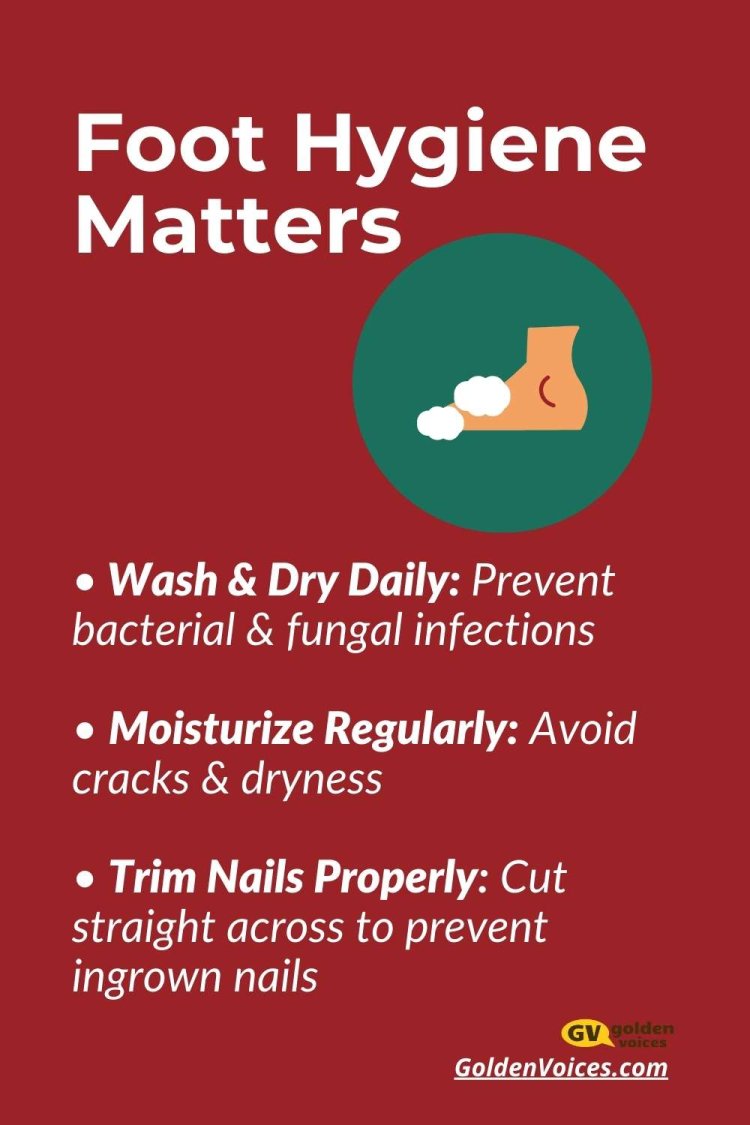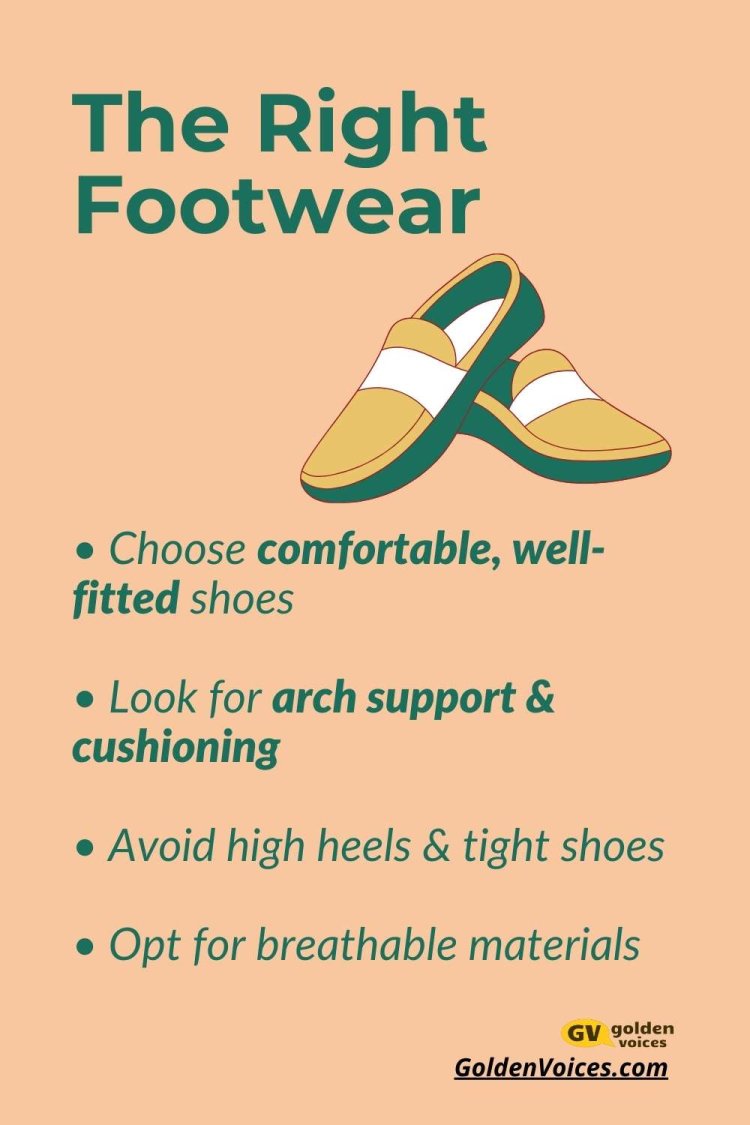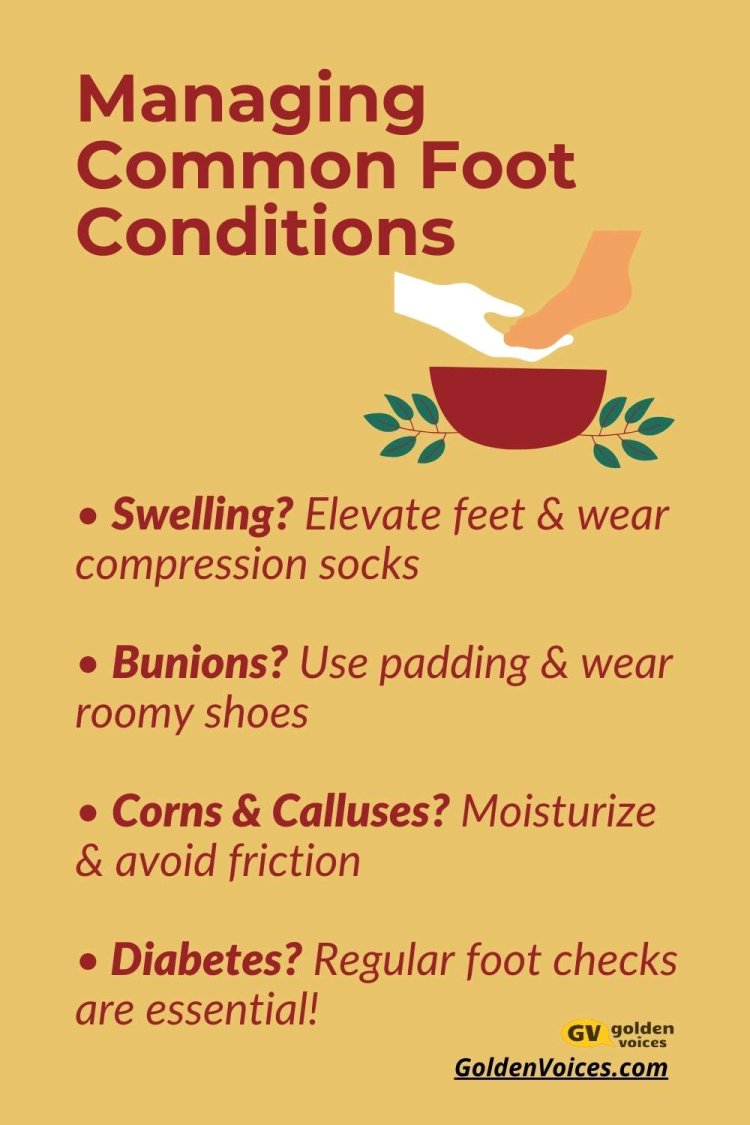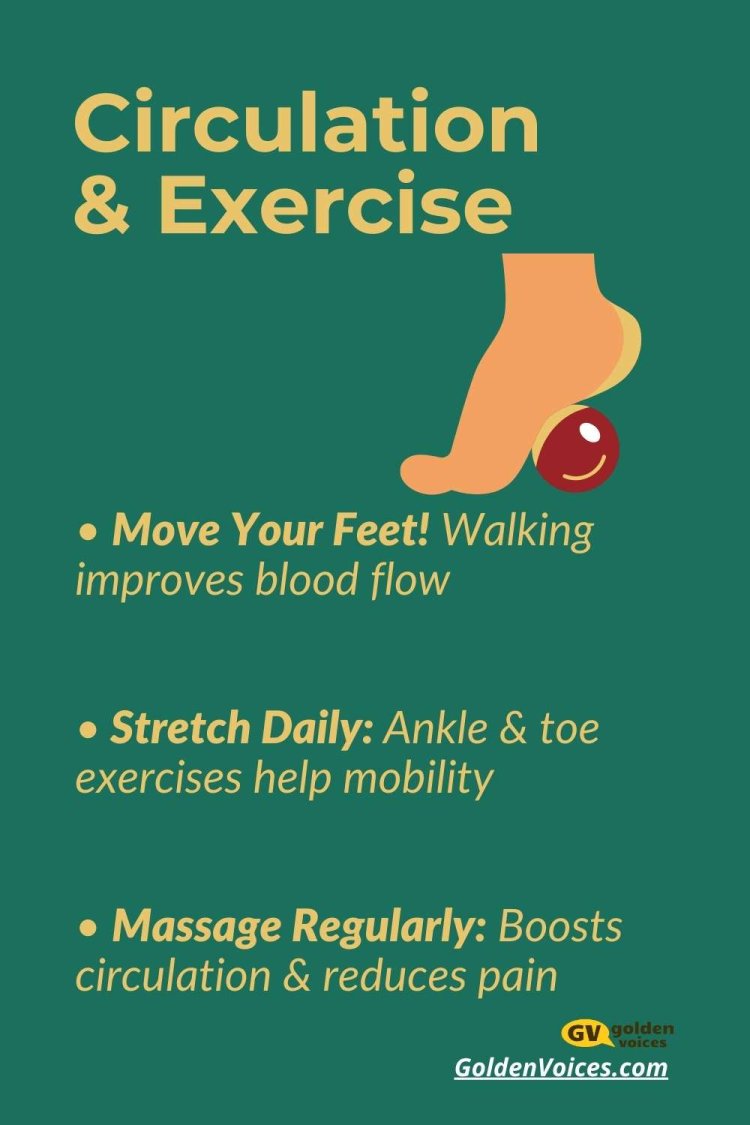Taking Care of Your Feet for Seniors
Foot problems can become more and more common as we age, but it is important for seniors to continue to take good care of their feet.

Most people take their feet for granted, but that’s just plain wrong says Jaquelyn Macknight, a registered nurse for over 40 years who specializes in foot care. Your feet are the parts of your body under the most pressure, she says. They carry you through life and support you through your daily activities. She advises that you should take good care of your feet, so you aren’t surprised with foot health issues later in life.
ADVERTISEMENT
What affects the feet also affects the rest of the body. Changing the position of the feet changes the position of the knees, which changes the position of the legs and hips, which affects the back, which affects the shoulders, and so on.
This means that it is vital to properly care for your feet and seek treatment or advice for any foot health issues you may be facing.
“If we do not take the steps that we need [to take] in order to make sure that our feet are healthy and comfortable […] we are going to be in trouble,” Macknight said.
So, here, she guides us through the most common problems we may face with our feet and ways to deal with them.
How can seniors take care of their feet?
The first step to foot care is to observe your feet. It is essential to know what is happening with your feet so that problems can be detected early and resolved quickly.
That first step doesn’t have to be complicated, Macknight says. You can do it in the bath or shower for convenience. Ensure you have proper lighting to help you observe every part of your feet. In addition to inspecting your feet visually, you should also touch your feet to determine if there’s sensitivity or pain.

Another critical component of taking care of your feet is hygiene. Each time you take a bath or shower, take special care to ensure your feet are clean. You should use a scrubbing brush to clean your feet when bathing. The brush can help clean your feet more thoroughly and make it easier for you to reach them. Using a brush also encourages blood circulation in the feet.
When cleaning your feet, make sure that you clean around your toenails and scrub off dead skin. This helps prevent the skin from cracking, which results from not enough cleaning, moisture, or circulation.
It is also important to dry your feet well and moisturize them. Using lotion is vital in preventing the development of cracks and skin injuries. Macknight suggests moisturizing your feet every day or at least each time you shower or bathe.
“It’s kind of like a very well-made leather, a very expensive leather,” she said. “If you keep it in good condition, it will last for 100 years. If you keep it moisturized, it will last for 100 years. Our skin is just like that.”
How to choose proper footwear as a senior
Choosing the proper footwear is extremely important for your foot health. Shoes support your feet and legs as you go about your daily activities, and ill-fitting shoes or shoes with the wrong structure can cause issues.

Avoid wearing flip-flops unless you are near a swimming area, as flat-soled shoes and sandals can cause pain due to their lack of support. Try to choose better-quality sandals that provide more arch support.
Choosing the right pair of shoes is equally important. Sizing is one of the qualities that most affect foot health, so your shoes must fit you properly. Macknight’s advice for finding the right size when shoe shopping is to bring a paper cutout of your feet.
At home, put a piece of paper on the floor and remove your shoes and socks. Next, trace around both of your feet, cut them out, and bring them to the shoe store. While you shop, take out the insole of a shoe and match it with your cutout. Find a shorter, thinner, wider, or longer size if they don’t match.
You should also avoid shoes with pointed toes. Most people’s feet are not shaped like a triangle, so shoes with rounded or flat toes will be much more comfortable and help you avoid issues like calluses.
If you have high arches and need extra support, look for shoes with high arches or find arch support insoles. Macknight recommends Dr. Scholl’s insoles.
If you are a senior wearing extremely structured or less structured shoes for your whole life, try not to switch the type of shoes you wear unless they are causing problems. However, you can add insoles for support or cushion.
“When you’re in your older ages, this is not necessarily the best time to decide to change the type of footwear you’re using,” Macknight said. “Go with what you’ve been using as long as it’s been working and you’ve been comfortable.”
Foot care concerns for diabetic seniors
People with diabetes need to be extra attentive to their feet. This is because diabetes can cause circulation issues and nerve damage in the feet, so you may not even notice problems that would typically cause pain.

If you have diabetes, make sure that you or someone else looks at your feet daily. You should also soak your feet for ten minutes twice a week to clean them and remove dead skin. Moisturize your feet daily to avoid cracks, which may be more difficult to heal due to diabetes.
If a wound does not heal, you should go to the hospital for treatment. You should also see a foot care specialist more often than someone who does not have diabetes. “We treat all issues with diabetics with a little bit more attention than we normally would with people who [do not have diabetes],” Macknight said.
What is athlete’s foot, and how is it treated?
Athlete’s foot is a fungal skin infection that usually occurs in people who have very sweaty feet while wearing tight shoes. It causes redness, makes the skin more sensitive to the touch, and makes your skin more likely to break.
If you have athlete’s foot, see your physician for treatment or advice. Macknight says she would not suggest many over-the-counter products for this condition, but you can ask your pharmacist, and they can help you find a good product for it.
Ensure that you clean your feet properly and wash socks after each wear. You also need to clean rugs, carpets, and slippers and treat them with antifungal powder to stop the condition from spreading. Treatment for fungal infections must be rigorous. Clean anything you step on every day and treat the feet every day.
How is athlete’s foot different from a fungal nail infection?
Athlete’s foot occurs on the skin of the foot, while fungal nail infections occur on the nails. Fungal nail infections are more common on the toenails than the fingernails.

Fungal nail infections cause a chalky white area that spreads across the nail to appear. They can worsen much faster if you are immunocompromised.
The only way to diagnose a fungal nail infection is to have your physician do a scraping of the nail to be assessed. However, these infections are so common that they may treat them without doing a nail scraping.
Like with athlete’s foot, you must wash and treat your socks, shoes, slippers, rugs, and carpets often. If you do not do this, the infection will spread much faster.
What are plantar warts, and how are they treated?
Plantar warts are flat warts that usually occur on the bottom or side of the foot. They are caused by an active virus, which means that they are picked up from elsewhere and can be spread.
Plantar warts can be removed using freezing or chemical or surgical methods. Usually, the least invasive techniques are used first. Warts are typically reduced until they are gone. Macknight suggests putting duct tape on the outside of your wart after a reduction to get rid of its oxygen source.
These warts can get very large if left untreated for a long time and can come back if the virus stays in your body. It may take a long time to treat plantar warts, or they may go away quickly, depending on how long the wart has been on the foot and how large it’s gotten.
What are ingrown toenails, and how are they treated?
Ingrown toenails happen when the side or corner of a toenail grows into the toe. They can be caused by shoes that don’t fit properly and push the toes together, nail damage, or consistent swelling of the feet.

To prevent ingrown toenails, let your nails grow slightly over the corner that it usually fits into and moisturize your feet. If you cut a nail extremely short and your skin is dry, the nail will grow into the tissue and not over it.
“Instead of cutting [the nail] below that so that it neatly fits within those two corners, we want people to get used to growing it over that,” Macknight said. “And I can honestly say in all of my years of being a foot care nurse, that has never failed to cure an ingrown toenail that is not horrifically bad.”
ADVERTISEMENT
There are other solutions for ingrown toenails. You can file the sides and corners of the nails and soak the feet frequently. If you have highly curved toenails that often grow into the skin, there are treatments to stop this from happening.
One treatment is called Onyfix. With this method, a powerful surgical adhesive is applied under the corners of the nail. This allows the nail to grow out normally because it holds it up and stops it from growing down into the toe. Surgery may be needed in extreme situations.
Corns, calluses, and bunions
Corns and calluses are thick layers of skin that develop from pressure or friction on the skin. Calluses are flat, while corns protrude from the skin’s surface and may be shaped like a kernel of corn. Corns and calluses can be easily reduced by filing them and using corn or callus pads, Macknight explains.
Bunions happen when the structure of the foot changes and the side of the foot begins to flatten and stick out. The issue of bunions can be solved surgically, but you can avoid pain by using padding and getting more comfortable, well-fitting shoes.

Corns, calluses, and bunions can all be avoided by wearing proper, well-fitting footwear and keeping your feet moisturized.
Other foot conditions and solutions for seniors
Hammertoe is a condition that occurs when the ligaments in the toe shorten, causing bending in the toe. You can use supports and padding to reduce callusing and pain with hammertoes. Surgical solutions to straighten hammertoes are also available.
Heel spurs are a condition caused by the bone in the heel growing a bony protrusion, which can cause pain. Depending on the severity of a heel spur, it can be treated with various treatments, including orthotics, padding, medication, and surgery.
Plantar fasciitis is another common cause of heel pain. This is caused by inflammation of the tissue connecting the heel bone to the toes. The treatment of plantar fasciitis can be a long-term process, but you can reduce pain with specific daily exercises.
Fallen arches can be quite painful. If you’ve had high arches your whole life, your arches can collapse as you age. Pain in your arches can be solved by putting arch support insoles in your shoes. These can be specialized orthotics or store-bought insoles.
Fatigue fractures are fractures in the bones caused by excessive load and stress. To treat fatigue fractures, you need to see a doctor and get an x-ray. Treatments include strapping for minor fractures or casting in more severe situations. Fatigue fractures in the feet are extreme situations and must be treated as soon as possible, so they do not get worse.

Arthritis is inflammation in the joints. This can happen in any joint in the body and becomes more common as we age. If you have arthritis, it is essential to continue the movement of your joints, even if it is painful. If you don’t use your muscles, they can turn into a type of cement that will make movement even more painful, Macknight explains. You might want to get medicine or a medicated lotion or balm to reduce inflammation.
Excessively sweaty feet and foot odour can be a big problem for some individuals. This can be caused by doing heavy work while wearing tight shoes or boots, as a side effect of certain medications, and even genetics. To prevent excessive sweating and odour, wash your feet well, change socks daily, and wear white cotton or wool socks that wick moisture. Macknight explains adds that you can also get over-the-counter foot odour products like Dr. Scholls and Flexeril to help with this issue.
Exercises seniors can do to promote foot health
Here are some exercises Macknight recommends to keep your feet strong and healthy. These exercises can all be done in bed and should be done a few times in a row, twice a day:
- Wiggle your toes.
- Foot pedals. Move your feet in an up-and-down motion as if you’re pressing on a sewing machine foot pedal.
- Side-to-side motions. This exercise is similar to the foot pedal motion but moves side-to-side instead.

You can also use exercises to increase circulation to the feet:
Put your feet flat on your bed while lying down. Next, bring one foot back slowly to hit your rear end, then move it back slowly. Do this ten times in the morning and night.
Only do these exercises if you know they will not hurt you.
“Always make sure that you do not do anything that your body is not easily capable of doing,” Macknight said.
What can seniors expect when visiting a foot specialist such as Macknight’s Elliot Lake Foot Care service?
First, Macknight does a full assessment of the feet. She checks foot temperature and blood flow, looks for calluses and corns, checks out the nail structure, and looks for ingrown toenails.
She talks to the patient about what they believe needs to be done, and then they discuss a plan of care and a solution.
People of any age can visit Elliot Lake Foot Care. Macknight sees clients in clinics, hospitals, long-term care or retirement facilities, and their homes.
Don’t be afraid to seek care if you have foot health issues. “If we take care of our feet, our quality of life is so much better,” Macknight said, “and it just takes a little bit to make sure that we maintain the health of our feet.”
BIO

Jaquelyn Macknight has been a registered nurse for over 40 years and specializes in dementia care and foot care. She is the owner of Compassion in the Moment: Dementia Care Consulting and Elliot Lake Foot Care. For Compassion in the Moment, she provides education and support services for dementia caregivers. For Elliot Lake Foot Care, she provides foot care and wound care assessments and treatment for conditions like warts, corns, calluses, and ingrown toenails.
For more information go to: Elliot Lake Foot Care

 Anna Noseworthy-Turgeon
Anna Noseworthy-Turgeon 





